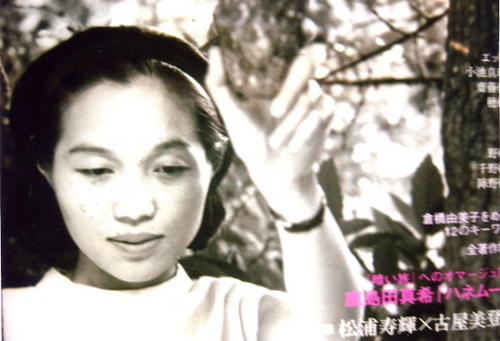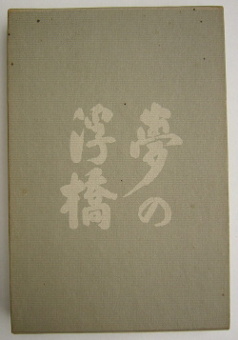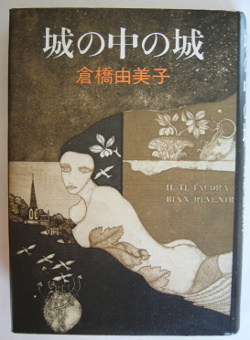|
Kurahashi Yumiko in Yume no ukihashi (The Bridge of Dreams), as has been noted in our introduction, tried to combine the Austenian novel of a young woman’s growth and marriage with classical Japanese women’s fiction, as represented by The Tale of Genji. This experimental coupling involves a mutual tempering of the confidently human world of Austen, where a heroine can demand to be treated as a “rational creature”—for example, Elizabeth Bennet (PP 122) and Mrs. Croft (P 75)—, and the anarchic sexual world of the Japanese classic, where one of the main female characters, after a tormenting love life tries to drown herself in despair, is saved by a saintly monk, and finally seeks peace in a Buddhist convent.1 This daring mixture represents the collision of two distinct viewpoints on love and on life.
The heroine Keiko lives the life of an upper-class young woman in contemporary Tokyo. She intersperses her college life of attending lectures, writing academic papers, and joining student clubs with the traditional seasonal pursuits of the Japanese bourgeoisie such as cherry blossom picnics and autumn-moon viewings, kimono-clad tea ceremonies and visits to Noh performances. Even for a daughter of a wealthy business executive, such a lifestyle is largely an idealized piece of fiction, rendered just plausible by small touches of contemporary Japanese urban life. This mingling of the contemporary domestic scene and the elegancies of classical Japanese literature had already produced works like The Makioka Sisters (1948) by Tanizaki Jun’ichirō (1886-1965) and Thousand Cranes (1952) by Kawabata Yasunari (1899-1972), and this novel contains obvious echoes from both.2 But The Bridge of Dreams is distinctive because, although narrated in the third person, it is constructed entirely from a girl’s viewpoint, which is brought to the fore by making the heroine write a thesis on Jane Austen. Unlike the novels of Tanizaki and Kawabata, where the women are essentially the objects of male attention, Kurahashi’s novel is constituted by female subjectivity, and by what that subjectivity desires. To convey the feel of the story, a rough plot outline follows.
Keiko and her boyfriend Kōichi arrange to meet in the ancient city of Kyoto. While she awaits him in the garden of a temple, she sees her mother waiting for someone. She intuits that her mother is having an affair with another man. Meanwhile Kōichi also sees his mother in another temple. The secret of their parents comes gradually to light. Under the initiative of Keiko’s father, the two couples have been for some time in a four-sided relationship. Fujino, a woman antique dealer and their friend, has provided cover for their affairs by hosting regular tea ceremonies in her villa in Kyoto. When they realize that their daughter has her suspicions about them, the four lovers/parents start maneuvering to prevent their offspring from marrying. They know that there is a chance that Keiko and Kōichi are brother and sister.
An old family friend persuades Keiko to give up Kōichi. Keiko accepts his advice without question. By now her suspicions have taken a definite form. But her cool rationality is belied by her dreams, in which she crosses a bridge, the bridge of dreams of the title, to “the other side of the world” (98), where she becomes fused with Kōichi’s soul. The possibility of incest does not frighten the lovers, but they agree that they will each find a different partner. Keiko believes that her relationship with Kōichi will not be changed by the truth or otherwise of the possibility of incest. Keiko and Kōichi both marry through the most traditional form of arranged marriage, both with impeccable partners. Meanwhile Keiko has been working on her graduate thesis on Jane Austen, completing it just before her marriage. Her writing on Austen is not reproduced in the novel, but we can be fairly sure that she sees Austen’s novels as a kind of life model.
With the death of Fujino the foursome of the older generation break up, each returning to his or her legitimate spouse. But Keiko, convinced amoralist under her demure surface, begins to dream that she and her husband, with Kōichi and his new wife, can go over “that bridge” and play on “the other side of the world” (191). To the end, the shadow of incest is neither confirmed nor disproved, but, given the otherworldly nature of Keiko’s relationship with Kōichi, perhaps it does not matter. The story ends with a repeat of the winter scene in Kyoto as Keiko and Kōichi meet again—this time waiting for the phone call from her husband saying he has settled in a hotel room with Kōichi’s wife.
The Bridge of Dreams, despite its depiction of anarchic sexual impulses, is predicated on a stable and ordered social world. Though the novel unfolds in the early 1970s, against the background of student demonstrations and occupations of the campus buildings, daily life flows on as if these happenings are nothing more than noises in the street. Keiko is a natural conservative, unaffected by the turmoil and coolly looking down on what she sees as the antics of the radical students. Kurahashi implies that Keiko can afford to ignore these outside influences partly through her recognition of the firm human order that she finds in the fictional world of Austen. As Kurahashi states in one of her essays:
Reading an Austen novel one feels that it may be permissible to regard it as an agōn, that is a game of competitive strength, but an agōn the rules of which do not see the winner monopolizing the reward and the loser being annihilated, but the reward, in this case happiness, being distributed according to the luck and degree of human excellence of the players. (Meiro no tabibito 94-95)3
Kurahashi admires the consistency and precision of Austen’s comic vision. Although that comedy is a game and therefore artifice, not rooted in the nature of things but subject to contingency (“luck” partly determines the outcome), nevertheless this game more or less reflects the workings of a human order. Kurahashi believes in the necessity of this human order. Not accepting such an order, even with its irreducible element of contingency, is to be stupid and weak. Her heroine Keiko firmly adheres to the values and customs of this order: it gives her the confidence and moral stamina to dismiss social disruptions such as university unrest as outside noise.
Yet we find in later Austen an increasing questioning of this human order. Fanny Price feels amazed at how her heart has been swayed by the vagaries of chance: “She began to feel that she had not yet gone through all the changes of opinion and sentiment, which the progress of time and variation of circumstances occasion in this world of changes” (MP 431). Anne Elliot can be quite eloquent about the need for “a cheerful confidence in futurity” which does not “insult exertion and distrust Providence” (P 32). But Wentworth’s account of his narrow escape from a storm, after which his death notice, like those of countless other naval officers, might easily have made only “a small paragraph at one corner of the newspapers” (P 71), hints at the precariousness of her position. If we follow Kurahashi’s interpretation of the Austenian novel, these intimations of mutability would mark the limits of the human order constructed within Austen’s fiction. This is where The Bridge of Dreams, ostensibly a novel of domestic realism modeled on the novels of Austen, opens itself to a world beyond the bridge, where the memories of The Tale of Genji and Noh plays throng and reverberate in a dreamlike dance of anarchic desires.
It is the originality of Kurahashi’s heroine that she encompasses the world of everyday reality and the world of “dreams” and that she draws her strength from the combination. Her deliberate conservatism is part of a more general independence of character that is able to disregard not only shallow ideas of political radicalism but also conventional codes of female behavior. Keiko’s sense of herself as a “rational creature” is categorical; she is as confident as Elizabeth Bennet of her ability to be mistress of her own life, but she also desires to test the boundaries of her rationality. When Kurahashi said that a conventional lifestyle and sexual libertinism can be made compatible in fiction, she was harking back to the classic Japanese novel, with its elegant portrayal of court life and almost promiscuous sexual relations, and proposing a type of heroine who is at once deeply conservative and independent enough to risk losing her identity by going beyond ordinary morality.
This transcending of morality is represented by the incest theme. The incest theme had been Kurahashi’s concern from the beginning of her literary career,4 and the uniqueness of her treatment lies in the fact that she presents incest as the projection and embodiment of a female desire that empowers her female characters. In The Tale of Genji it is the male hero, Genji the Shining Prince, who embarks on a semi-incestuous relationship with the noblest of the ladies of his father the Emperor. He is a paragon or ideal of love-making, courting and winning a prodigious number of women, both noble and simple. But in Kurahashi’s novel, Keiko is the bold incestuous player of the game of love. She is drawn to many men and feels quite uninhibited about it. As well as her boyfriend Kōichi and her prospective husband, she becomes quite amorous with the school athlete Maeda and also with Professor Hotta, the Dean of her university with a head “like that of a middle-aged lion” (113). Clearly, then, Keiko in some ways is a female version of the Shining Prince in a rewriting of The Tale of Genji.
By introducing the theme of sexual anarchy and transgression as well as the idea of “the other side of the world” that underlies this world of illusion, both prominent features of The Tale of Genji, Kurahashi attempts to extend the human world of Jane Austen through “the other world” of terror and mystery, which, in Kurahashi’s vision, deepens that human order. Many of the women of this novel—not only Keiko, but also Fujino, the tea ceremony hostess, and Mariko, the wife of Kōichi—live lives of hard realism at the same time they respond to and face impulses that come from outside the human order. This mixture of the everyday and the erotic is presented as a fulfillment of their deepest selves, making these women fuller and braver human beings: it renders the world of the novel more precariously beautiful. Kurahashi’s experiment introduces the unreal, the transgressive, and the erotic into Austenian domestic realism, resulting in a radical mutation of the Austen model. Notes 1. Most discussions of The Tale of Genji center on the increasing darkening of tone after the brilliant portrayal of court life in the first third of the novel. For a Buddhist interpretation of this turn of the story see Konishi (326-74).
2. Tanizaki used the same title for his novella of 1959, in which the protagonist keeps dreaming of an incestuous relationship with his mother. As for Kawabata, Kurahashi herself states that her novel is modeled on Kawabata, although “strictly cleaned and deodorized of the smell of death,” which Kurahashi sees as pervading Kawabata’s aesthetic (Afterword, The Bridge of Dreams 219). See also Aya Satoh’s interesting comparison of Pride and Prejudice and The Makioka Sisters. Unless otherwise indicated, quotations from Japanese texts have been translated by the author.
3. Kurahashi bases this analysis on the theory of Roger Caillois, French philosopher and sociologist, who in Les jeux et les hommes (1958) proposed to categorize human play into four forms: agōn (competitive strength), alea (chance), mimicry, and ilinx (vertiginous thrill). The book was translated into Japanese in 1970, and Kurahashi probably read this translation.
4. In Sei shōjo (The Sacred Maiden, 1965), Kurahashi presented a teenage girl’s frantic attempts to dream into existence an incestuous relationship with her absent father. Wilder and more densely written than The Bridge of Dreams, this novel was recently reprinted and helped cause a renewal of interest in Kurahashi, as manifested by the issuing of a special number of one literary magazine (Bungakukai) and the publication of a handbook (A Kurahashi Yumiko Handbook). Works Cited Austen, Jane. The Cambridge Edition of the Works of Jane Austen. Gen. ed. Janet Todd. Cambridge: CUP, 2005-08. Bungakukai [magazine] 63.4 (Apr. 2009). Kurahashi Yumiko spec. issue. Callois, Roger. Asobi to Ningen. [Les jeux et les hommes.] Trans. Shimizu Kitarō and Kiryu Kazuo. Tokyo: Iwanami Shoten, 1970. Konishi, Jin’ichi. A History of Japanese Literature, vol.2: The Early Middle Ages. Trans. Aileen Gatten. Princeton: PUP, 1986. Kurahashi, Yumiko. Meiro no tabibito [The Traveler of the Labyrinth]. Tokyo: Kodansha, 1975. _____. Yume no ukihashi [The Bridge of Dreams]. Kurahashi Yumiko Zen Shōsetsu [Collected Fiction]. Vol. 8. Tokyo: Shinchōsha, 1976. 41-201. _____. Afterword to Yume no ukihashi. Collected Fiction. Vol. 8. 217-25. A Kurahashi Yumiko Handbook. Tokyo: Kawade Shobō, 2008. Mulhern, Chieko I. Japanese Women Writers: A Bio-critical Sourcebook. Westport, CT: Greenwood, 1994. Satoh, Aya. “Caught between Old and New: The Changing Face of Marriage in Austen and Tanizaki.” Persuasions On-Line 28.2 (2008).
|




